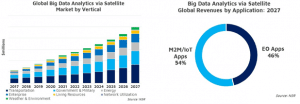 NSR’s Big Data Analytics via Satellite, 2nd Edition report finds downstream Big Data solutions continue on a sustained growth path over the next decade, largely driven by Earth Observation and M2M/IoT applications in several key markets. Big Data analytics via satellite will generate close to $18.1 billion in cumulative revenues by 2027, owing to increasing demand from end users in the transportation, government and military, and energy sectors.
NSR’s Big Data Analytics via Satellite, 2nd Edition report finds downstream Big Data solutions continue on a sustained growth path over the next decade, largely driven by Earth Observation and M2M/IoT applications in several key markets. Big Data analytics via satellite will generate close to $18.1 billion in cumulative revenues by 2027, owing to increasing demand from end users in the transportation, government and military, and energy sectors.
The highest increase in usage across key verticals will be seen in use of satellite imagery for data analytics applications, growing at an impressive 23.5% CAGR through to 2027.
“However, this is only half the story, as machine-to-machine communications and IoT technologies contribute a significant portion of the revenue opportunity as well,” stated Shivaprakash M, NSR Analyst and report author. “Whether this demand is for fleet management solutions, financial instruments or decision tools; there is a significant shift in the industry. Multiple players along the value chain are focusing on squeezing maximum value out of pixels and bits.”
Overall, satellite Big Data analytics will reach close to a $3 billion revenue opportunity by 2027, with 54% from M2M/IoT applications and 46% from EO applications. Through the next decade, although North America will continue to have a lion’s share of the revenue opportunity, demand in other world regions are expected to grow at an accelerated pace as more markets in more regions embrace the digital paradigm.
